The first time I said SaaS would never be the same was referring to Freshbook’s launch of their benchmarking service:
It’s *the* hidden business model enabled by SaaS. An opportunity not talked about, but so obvious it has to be on the back of all SaaS CEO’s mind. Benchmarking is a huge business, practiced by research firms like Forrester, Hoovers, Dunn and Bradstreet, as well as by specialized shops like the Hackett group – none of which are affordable to small businesses. More importantly, all previous benchmarking efforts were hampered by the quality of source data, which, with systems behind firewalls was at least questionable. SaaS providers will have access to the most authentic data ever, aggregation if which leads to the most reliable industry metrics and benchmarking.
Hosting customer data offers a lot more opportunities, beyond benchmarking. Tomorrow CRM provider Salesforce.com will launch a new service called Salesforce to Salesforce (S2S) that facilitates the sharing of data between customers -reports TechCrunch. I believe, just like Freshbook’s move, the ramifications of this new Salesforce service will go way beyond the immediate opportunities it brings to customers ( not that those are negligible: see first reaction by Echosign CEO Jason Lemkin, another business innovator in my book.)
This is a first step in a paradigm-shift: while current concerns about SaaS mostly focus on the security, privacy, and consequently isolation of business data, eventually a culture of controlled sharing for business benefits will develop. Forget CRM; think of more complete business suites, like NetSuite, or when it really kicks in, SAP’s Business ByDesign, the most comprehensive SaaS business suite ever. Procurement, manufacturing, inventory, resources…etc data – can you envision the improvements in Supply Chain visibility? SaaS will never be the same – again.
Update (12/5): Larry Dignan at Between the Lines sees the same opportunity:
Today, the service is predictably focused on sharing sales lead and CRM-type information. But as Salesforce.com grabs more large customers its possible that the latest service could be used to exchange supply chain information and link other business processes.

 24SevenOffice
24SevenOffice
 (Updated)
(Updated)
 ). Clearly, the majority of new IE7 users are not IE6 upgraders, they came from the Firefox camp.
). Clearly, the majority of new IE7 users are not IE6 upgraders, they came from the Firefox camp.






Recent Comments